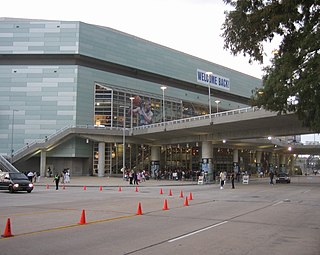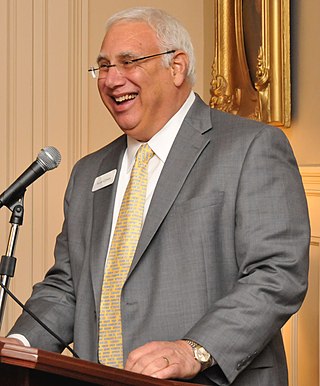
Hurricane Katrina was a devastating and deadly Category 5 Atlantic hurricane that caused 1,836 fatalities and damages estimated between $97.4 billion to $145.5 billion in late August 2005, particularly in the city of New Orleans and its surrounding area. At the time, it was the costliest tropical cyclone on record, later tied by Hurricane Harvey in 2017. Katrina was the twelfth tropical cyclone, the fifth hurricane, and the third major hurricane of the 2005 Atlantic hurricane season. It was also the fourth-most intense Atlantic hurricane to make landfall in the contiguous United States, gauged by barometric pressure.

As the center of Hurricane Katrina passed southeast of New Orleans on August 29, 2005, winds downtown were in the Category 1 range with frequent intense gusts. The storm surge caused approximately 23 breaches in the drainage canal and navigational canal levees and flood walls. As mandated in the Flood Control Act of 1965, responsibility for the design and construction of the city’s levees belongs to the United States Army Corps of Engineers and responsibility for their maintenance belongs to the Orleans Levee Board. The failures of levees and flood walls during Katrina are considered by experts to be the worst engineering disaster in the history of the United States. By August 31, 2005, 80% of New Orleans was flooded, with some parts under 15 feet (4.6 m) of water. The famous French Quarter and Garden District escaped flooding because those areas are above sea level. The major breaches included the 17th Street Canal levee, the Industrial Canal levee, and the London Avenue Canal flood wall. These breaches caused the majority of the flooding, according to a June 2007 report by the American Society of Civil Engineers. The flood disaster halted oil production and refining which increased oil prices worldwide.

Hurricane preparedness in New Orleans has been an issue since the city's early settlement because of its location.
From 1890 through 2006, the Orleans Levee Board (OLB) was the body of commissioners that oversaw the Orleans Levee District (OLD) which supervised the levee and floodwall system in Orleans Parish, Louisiana The role of the OLB has changed over time. Prior to Hurricane Betsy in 1965, the OLB developed land and sold it to raise money to build and improve flood protection levees. After Betsy, Congress passed the Flood Control Act of 1965 which directed the Army Corps of Engineers to design and build the hurricane flood protection system enveloping New Orleans. Owing to the 1965 legislation, the OLB's duties were now limited to collecting the 30% cost share for project design and construction, and to maintaining and operating completed flood protection structures.

Hurricane Katrina struck the United States on August 29, 2005, causing over a thousand deaths and extreme property damage, particularly in New Orleans. The incident affected numerous areas of governance, including disaster preparedness and environmental policy.

Walter Joseph Boasso is an American businessman and Democratic former state senator from Chalmette, the seat of government of St. Bernard Parish in south Louisiana. He was defeated in a bid for governor in the October 20, 2007, nonpartisan blanket primary by the Republican Bobby Jindal. Boasso won 47 percent in his own St. Bernard Parish, his sole plurality showing in any of his state's sixty-four parishes. From 2004 to 2008, Boasso represented Senate District 1, which includes parts of Orleans, Plaquemines, St. Bernard, and St. Tammany parishes, many of those areas having been devastated by Hurricane Katrina.
On Monday, August 29, 2005, there were over 50 failures of the levees and flood walls protecting New Orleans, Louisiana, and its suburbs following passage of Hurricane Katrina. The failures caused flooding in 80% of New Orleans and all of St. Bernard Parish. In New Orleans alone, 134,000 housing units — 70% of all occupied units — suffered damage from Hurricane Katrina and the subsequent flooding.

Ivor van Heerden is a South African-born American scientist, recognized for his work in the marine sciences and his significant contributions in the field of hurricane research. He was the deputy director of the Louisiana State University (LSU) Hurricane Center; however his tenure at LSU ended in 2010, when he was dismissed by the university under controversial circumstances following his criticism of the handling of Hurricane Katrina.

Southern University at New Orleans is a public historically black university in New Orleans, Louisiana. It is a member of the Southern University System and the Thurgood Marshall College Fund.
The Southeast Louisiana Flood Protection Authority (SLFPA) was established by Louisiana state law Revised Statute §38:330.1 in September 2006. Its operation began in January 2007. The Authority consists of two regional levee boards which oversee flood protection in the Greater New Orleans area on the east and west banks of the Mississippi River. Commissioners of both Authorities have clearly defined term limits. The Authority also has a Nominating Committee.

When the Levees Broke: A Requiem in Four Acts is a 2006 documentary film directed by Spike Lee about the devastation of New Orleans, Louisiana following the failure of the levees during Hurricane Katrina. It was filmed in late August and early September 2005, and premiered at the New Orleans Arena on August 16, 2006 and was first aired on HBO the following week. The television premiere aired in two parts on August 21 and 22, 2006 on HBO. It has been described by Sheila Nevins, chief of HBO's documentary unit, as "one of the most important films HBO has ever made." The title is a reference to the blues tune "When the Levee Breaks" by Kansas Joe McCoy and Memphis Minnie about the Great Mississippi Flood of 1927.

Stanwood Richardson Duval Jr. is a former United States district judge of the United States District Court for the Eastern District of Louisiana. He was appointed by U.S. President Bill Clinton in 1994.
The Louisiana Coastal Protection and Restoration Authority (CPRA) is a governmental authority created by the Louisiana Legislature in the aftermath of Hurricanes Katrina and Rita. The organization takes advantage of both federal and state funding of around $1 billion annually. Since its founding, the organization has dredged over 60 miles of sediment into islands and artificial land, as well as 36,000 acres of marshland. CPRA predicts that over the next 50 years, over 1,450 square miles of land in Louisiana could be lost along coastal areas.
The Flood Control Act of 1965, Title II of Pub. L.Tooltip Public Law 89–298, was enacted on October 27, 1965, by the 89th Congress and authorized the United States Army Corps of Engineers to design and construct numerous flood control projects including the Lake Pontchartrain and Vicinity, Louisiana Hurricane Protection Project in the New Orleans region of south Louisiana.
The United States Army Corps of Engineers is involved with a wide spectrum of public works projects: environmental protection, water supply, recreation, flood damage and reduction, beach nourishment, homeland security, military construction, and support to other Governmental agencies. Through 19 Flood Control Acts since 1917, Congress has authorized the Corps of Engineers to be involved with flood protection and damage reduction in almost every state of the union.
The United States Army Corps of Engineers is involved with a wide spectrum of public works projects: environmental protection, water supply, recreation, flood damage and reduction, beach nourishment, homeland security, military construction, and support to other Governmental agencies. In nineteen (19) different Flood Control Acts since 1917, the United States Congress has authorized the corps to design and build flood protection projects and one risk reduction system in the Greater New Orleans area and throughout the nation.

Scott S. Cowen is president emeritus of Tulane University in New Orleans, Louisiana, where he was also Seymour S. Goodman Memorial Professor in the A.B. Freeman School of Business and professor of economics in Tulane's School of Liberal Arts. He was interim president of Case Western Reserve University in Cleveland, Ohio from 2020 to 2021, and currently serves as Distinguished Presidential Visiting Professor of Leadership and Management at CWRU. He has written more than a hundred peer-reviewed journal articles and five books. His most recent book, Winnebagos on Wednesdays: How Visionary Leadership Can Transform Higher Education, was published by Princeton University Press in 2018. Cowen is the eponym of Tulane's Cowen Institute and chairs its board of advisors. Cowen served as Tulane's 14th president from July 1998 through June 2014.

If God Is Willing and da Creek Don't Rise is a 2010 documentary film directed by Spike Lee, as a follow-up to his 2006 HBO documentary film, When the Levees Broke: A Requiem in Four Acts. The film looks into the proceeding years since Hurricane Katrina struck the New Orleans and Gulf Coast region, and also focuses on the 2010 BP oil spill in the Gulf of Mexico and its effect on the men and women who work along the shores of the gulf. Many of the participants in Levees were also featured in this documentary.

There are three outfall canals in New Orleans, Louisiana – the 17th Street, Orleans Avenue and London Avenue canals. These canals are a critical element of New Orleans’ flood control system, serving as drainage conduits for much of the city. There are 13 miles (21 km) of levees and floodwalls that line the sides of the canals. The 17th Street Canal is the largest and most important drainage canal and is capable of conveying more water than the Orleans Avenue and London Avenue Canals combined.

Sandy Rosenthal is an American civic activist and founder of Levees.Org, an organization created in October 2005 to educate the American public about the cause of the levee failures and catastrophic flooding in New Orleans during Hurricane Katrina.












